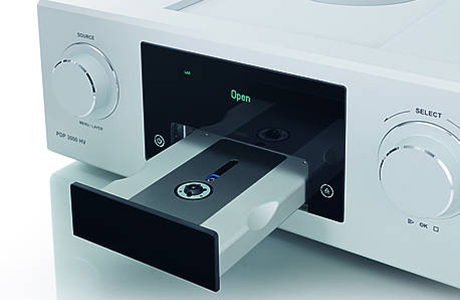A couple of initial impressions. The build quality is outstanding. Simply outstanding. Probably the best I've ever seen on any component. The T+A PDP 3000 HV encompasses total channel separation throughout the entire design. It has TWIN power supplies feeding the PDP 3000 HV's analog and digital sections separately. Yes, that means, it takes two power cords! T+A considers this a no compromise approach to building a world class digital front end. The CD/SACD mechanism is shielded in separate housing and the tray mechanism is as good as I've ever seen. Dead quiet and built like a tank. The tray does require you to use the included "puck" which you place on top of your CD/SACD prior to closing the door. Inside the separate housing for CD/SACD are "two close tolerance pushrods which divorce it from the heavy outer case, a high-torque synchronous motor moving the block by means of a decoupled spindle" - whatever the hell that means.

The PDP 3000 HV also completely separates the PCM data from the DSD data, keeping each in their purist manner possible. This means, on the back of the PDP 3000 HV, there are separate XLR (and RCA) outputs for PCM and DSD. As an option, you can choose to have all PCM data routed via the DSD DAC should a person not want to use up two inputs on their preamp. Fortunately for me, I have plenty of inputs and this was not a problem. For PCM (redbook) I use input 2 on my preamp. For DSD/SACD I use input 3. Subsequently, the T+A HV series preamp (P 3000 HV) has technology built in to "sense" the PCM or DSD signals and switch inputs without a hitch. Once again, if someone finds this too cumbersome, everything can be fed out through the DSD XLR (or RCA) outputs.
For DSD, T+A built their own real 1 bit converter using discrete parts so that that DSD signal is preserved throughout with no alternations and certainly no dumbing down to low-bit PCM. The PDP 3000 HV also includes a world class jitter-free clock for both switching stages.
It uses eight TI Burr-Brown 32-bit/384khz delta-signma DAC's in a double symmetrical quadruple arrangement. Oversampling is carried out by a 56 bit DSP and there are four filter options that can be selected using the remote. The four filter options vary based on filter order, slope, cut off frequency, etc. The Ti Burr-Brown DAC chips handle all PCM, SACD, and DSD 64. If you are using the USB input, you can override this by selecting the TrueDSD option. There are in addition, four DAC mode filters/settings to choose from.
How does it sound? Well, I have only tried redbook and SACD's. I have yet to experiment with the digital inputs (including USB) on the back - but I will. So far, I am completely blown away by its sonic capabilities - especially for redbook. Big huge sound. It has a delicacy and smoothness, without coloration. It handles sibilance very well and older, poorer recordings shine....well, shine as well as I've ever heard them.
At first, I was not overly impressed with its SACD sound, but then realized I had all the wrong settings for SACD playback. DOH! I am now using right settings, including SACD Filter 2 which is as "pure" a filter option as you can get for SACD material and it sounds sublime.
Dislikes? Well, not really a dislike, but more an admittance of not reading the manual. There is a screw in the bottom that locks the drawer for shipping that must be removed prior to playing a disc. It took me about 20 minutes to figure this out....or in other words, 30 seconds after reading the manual. Yes, its been WAY too long since I owned a spinner.
The remote is one heavy mother. There are four arrows on the remote pointing at 12 o'clock, 3 o'clock, 6 o'clock and 9 o'clock respectively. I am used to the ones at 3 and 9 denoting skipping to the next track or going back a track. That's not the case here. 12 o'clock skips forward and 6 o'clock goes back. 3 and 9 "scans" through a track. OK, not a big deal....but important to mention.
Navigating the menu's was quite easy. Very intuitive I found.
T+A is a world leading brand everywhere but here in America. It's a company that routinely builds products that European reviewers say should cost "3 or 4 times as much". Their products are constantly wining best of the year awards, like:
Once T+A gets a little better known here in America, I think the brand will become quite popular due to its amazing build quality and overall wonderful sonic purity - just like it is in Europe and other parts of the world.
More later...



